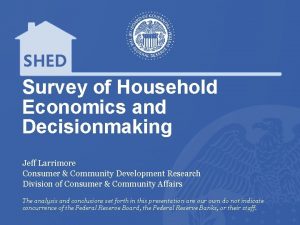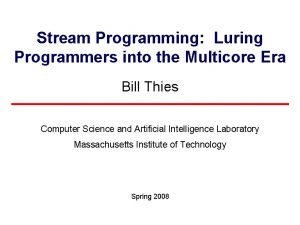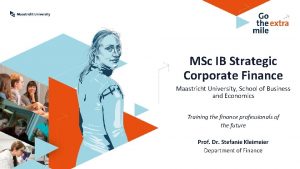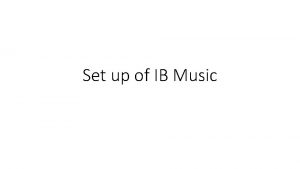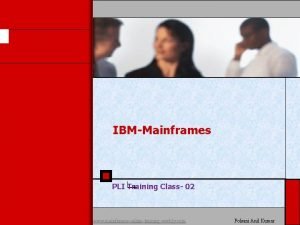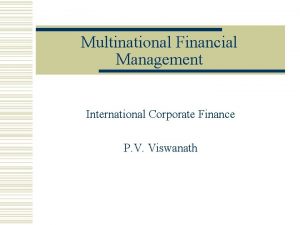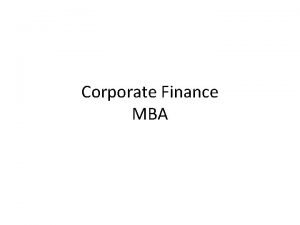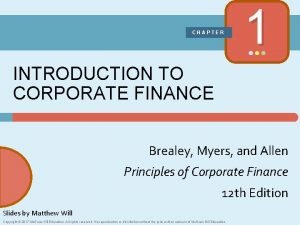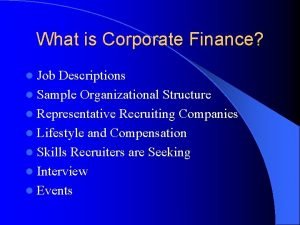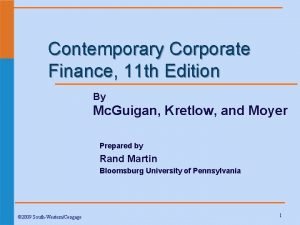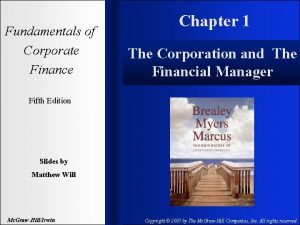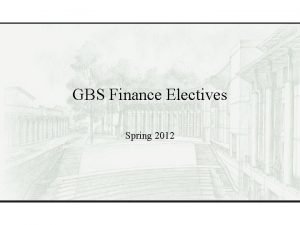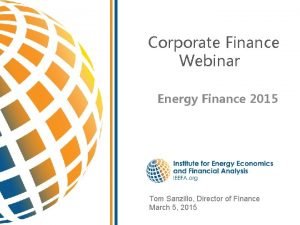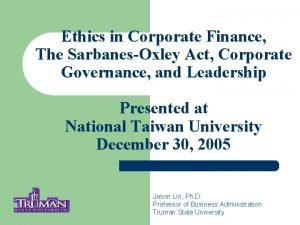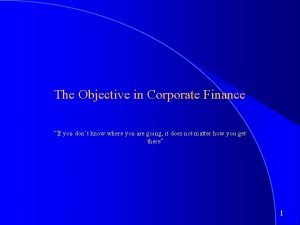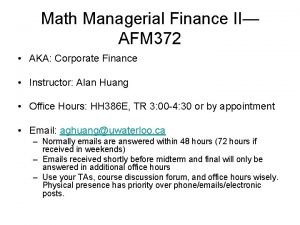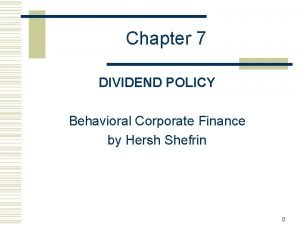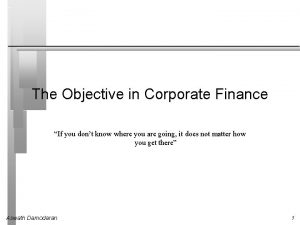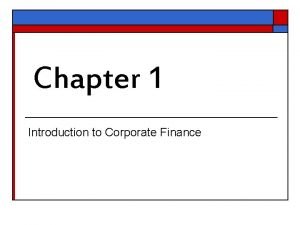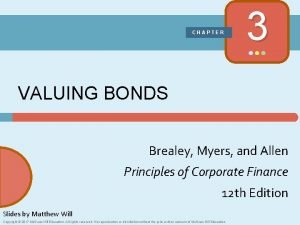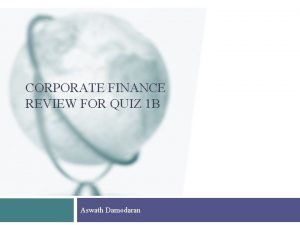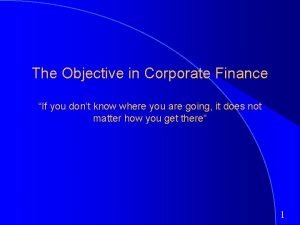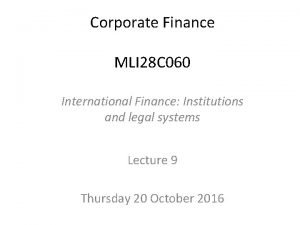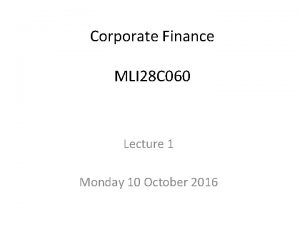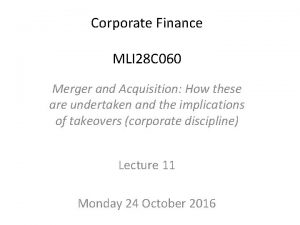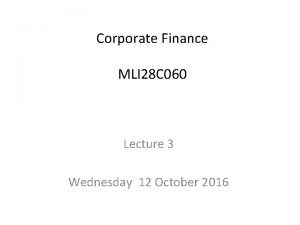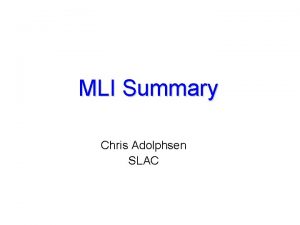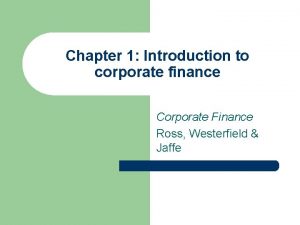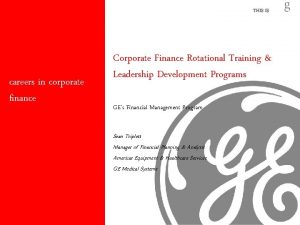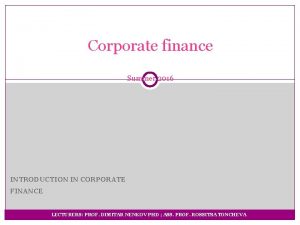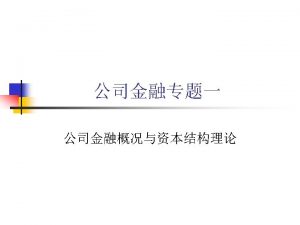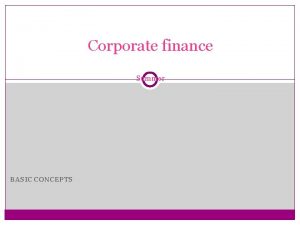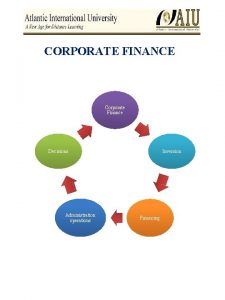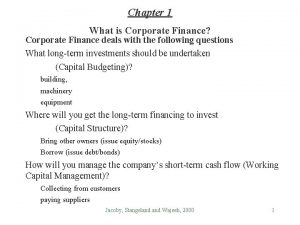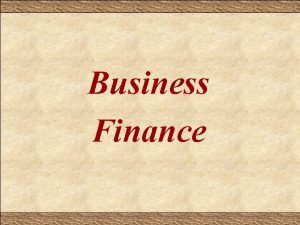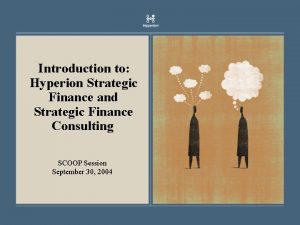Corporate Finance MLI 28 C 060 Strategic decisionmaking
































- Slides: 32

Corporate Finance MLI 28 C 060 Strategic decision-making: the role of investors and implications of dividend payout policy Lecture 13 Wednesday 28 October 2015

Reasons behind dividend policy payout

Introduction A payout policy is a set of principles regarding a corporation’s distributions to shareholders. – May be established with regard to a dividend payout, a dividend per share, a growth in dividend per share, or any other metric. – May include stock splits and stock dividends. – May include stock repurchases.

Optimal Dividend Policy • The optimal dividend policy should maximize the price of the firm’s stock holding the number of shares outstanding constant. A decision to increase dividends will raise D 1 putting upward pressure on P 0. Increasing dividends, however, means reinvesting fewer dollars, lowering g, and putting downward pressure on P 0. • Problem: What is the correct balance between dividends and retained earnings? • Second Problem: How realistic is it for company to have constant upward growth (g)

Constant growth formula also written as: Where Ro. E is ”Return on Equity” b is Plowback ratio BVps is Book Value per share Ke is Cost of Equity

Free Cash Flow: Distributions to Shareholders Sales revenues − Operating costs and taxes − Required investments in operating capital Free cash flow (FCF) = Sources Uses Interest payments (after tax) Principal repayments Dividends Stock repurchases Purchase of short-term investments 6

Implications to investors from dividend policy

Dividend Policy and Company Value: Theory Dividends Are Irrelevant Bird in the Hand • Based on MM theories. • If owners want a leveraged position, they can make it themselves. • Cash dividends are more certain than stock appreciation. Tax Argument • How dividends are taxed relative to capital gains affects investors preferences for dividends. Other • Clientele effect. • Signaling. • Agency cost effects.

Dividends are irrelevant In Miller and Modigliani’s (MM) world with no taxes, no transaction costs, and homogeneous information, dividend policy does not affect the value of the company. – The decision of how a company finances its business is separate from the decision of what and how much to invest in capital projects. – If an investor wants cash flow, he/she could sell some shares. – If an investor wants more risk, he/she could borrow to invest. – An investor is indifferent about a share repurchase or a dividend. Bottom line: Dividend policy does not affect a firm’s value.

The Bird-in-the-Hand Argument • Investors prefer a cash dividend to uncertain capital gains. – Hence, investors prefer the “bird in the hand. ” – Issue: Riskiness of the stock appreciation. • If this explanation holds, a company that pays a cash dividend will have a higher value than a similar company that does not pay a cash dividend. Bottom line: Dividend policy affects the value of the firm.

The Tax Argument If dividends are taxed at a rate higher than capital gains, investors prefer that companies reinvest cash flow back into the firm. – In other words, investors prefer the lower-taxed capital gains to the higher-taxed cash dividends. – This advocates a zero dividend payout when dividends are taxed at a rate higher than that of capital gains. Bottom line: Dividend policy affects the value of the firm.

The Clientele Effect • The clientele effect is the influence of groups of investors attracted to companies with specific dividend policies. – Clientele are simply a group of investors who have the same preference. • Types of clientele: – If an investor has a marginal tax on capital gains lower than the marginal tax on dividends, the investor prefers a return in the form of capital gains. – Investors who are tax exempt (e. g. , pension funds) are indifferent about dividends and capital gains. – Some investors, by policy or restrictions, only invest in stocks that pay dividends. • The importance of the existence of clientele is that investors will have a preference for stocks with a specific dividend policy. Bottom line: The clientele effect does not necessarily imply that dividends affect value.

Dividends and Signaling • Under MM’s theory, everyone has the same information. • When there is asymmetric information, dividend changes may convey information. Positive Information • Dividend initiations • Dividend increases Negative Information • Dividend omissions • Dividend reductions

Agency costs and Dividend policy • The separation of ownership and management in a corporation may lead to suboptimal investment. – Management may invest in negative NPV projects to enhance the company’s size or management’s control. • Jensen’s free cash flow hypothesis is that having free cash flow tempts management to make investments that are not positive NPV. – Paying dividends or interest on debt uses this free cash flow and averts an agency issue. • If a company’s debt has a restriction on paying dividends, it may avoid the issue of paying dividends (thus benefiting owners) and may increase the risk to bondholders. Bottom line: Dividends may reduce agency costs and, therefore, increase the value of the firm.

What’s the “residual distribution model”? • Find the reinvested earnings needed for the capital budget. • Pay out any leftover earnings (the residual) as either dividends or stock repurchases. • This policy minimizes flotation and equity signaling costs, hence minimizes the WACC.

Residual Model (Use this to calculate Distributions Paid) Net Distr. = income – Target equity ratio Total capital budget Net Distr. = – Required equity income

Formulae Required equity: (Equity ratio (ws) x Capital Budget) Distribution paid: (Net Income – Required equity) Payout ratio: (Dividend/Net Income) Dividend per share: (Dividend/No. Shares)

Application of the Residual Distribution Approach: Data for SSC • Capital budget: $112. 5 million. • Target capital structure: 20% debt, 80% equity. Want to maintain. • Forecasted net income: $140 million. • Number of shares: 100 million.

Application of the Residual Distribution Approach Number of shares Equity ratio (ws)(Target Cap. Structure) Capital budget Net income Req. equ. : (ws X Cap. Bgt. ) Dist. paid: (NI – Req. equity) Payout ratio (Dividend/NI) Dividend per share 100 80% $112. 5 $140. 0 $90. 0 $160. 0 ? ? ? ? ? ? ?

Implications for the marketing of finance to investors

Factors Affecting Dividend policy Investment Opportunities Expected Volatility of Future Earnings Financial Flexibility Tax Considerations Flotation Costs Contractual and Legal Restrictions

Factors affecting dividend policy • Investment opportunities: – A company with more investment opportunities will pay out less in dividends. – A company with fewer investment opportunities will pay out more in dividends. • Expected volatility of future earnings: – Companies with greater earnings volatility are less likely to increase dividends—a greater chance of not maintaining the increased dividend. • Financial flexibility: – Companies seeking more flexibility are less likely to pay dividends or to increase dividends because they want to preserve cash.

Factors affecting dividend policy • Tax considerations – The tax rate on dividends and how dividends are taxed relative to capital gains affect investors’ preferences and, hence, companies’ dividend policy. • Flotation costs – These costs make it more expensive to use newly issued stock instead of internally generated funds. – Smaller companies face higher flotation costs. • Contractual and legal restrictions – Forms of restrictions: • Impairment of capital rule • Bond indentures • Requirement of preferred shares

Tax Systems and Dividend Policy Consider a company that has earnings before tax of $100 million and pays all its earnings as dividends. The company’s tax rate is 35%, and individual shareholders have a marginal tax rate of 25%. In countries with a split-rate system, dividends are taxed at 28% at the corporate level. Double Taxation Earnings taxed at corporate level and dividends taxed at shareholder level Effective tax on dividends = 51. 25% Dividend Imputation Earnings taxed at corporate level and tax credit at shareholder level Effective tax on dividends = 25% Split-Rate System Earnings distributed are taxed at a lower rate than retained earnings Effective tax on dividends = 46%

Payout Policies •

The Procedures of a Dividend Payment: An Example • November 11: Board declares a quarterly dividend of $0. 50 per share to holders of record as of December 10. • December 7: Dividend goes with stock. • December 8: Ex-dividend date. • December 10: Holder of record date. • December 31: Payment date to holders of record.

Example: Payout Policies Consider the financial information for Apple, Inc. (AAPL) Fiscal Year Ending 9/29/2012 9/24/2011 9/25/2010 $41, 773 $25, 922 $14, 014 Net income (millions) 1. What are dividends for FY 2011 and FY 2012 if the company followed a stable dividend policy, with a target dividend payout of 10% and an adjustment factor of 0. 3? Fiscal Year Ending 9/29/2012 9/24/2011 $15, 851 $11, 900 Multiply by target 0. 10 Multiply by adjustment factor 0. 30 $475. 53 $357. 24 Increase in earnings Dividends

Example: Payout Policies 2. What are dividends for FY 2011 and FY 2012 if the company followed a constant dividend payout at 6%? Fiscal Year Ending Net income (millions) Multiply by 6% Dividends 9/29/2012 9/24/2011 $41, 773 $25, 922 0. 06 $2, 506 $1, 555. 32 3. What are dividends for FY 2011 and FY 2012 if the company followed the residual payout policy? Fiscal Year Ending Net income (millions) Less: capital expenditures Dividends 9/29/2012 9/24/2011 $41, 773 $25, 922 9, 402 7, 452 $32, 371 $18, 470

Cash Dividends vs. Repurchasing Stock • Reasons for preferring repurchasing stock over paying a cash dividend – Potential tax advantages – Signaling – Managerial flexibility – Offset dilution from executive stock options – Increase financial leverage • A stock repurchase may be a good alternative to an increase in cash dividends.

Global Trends in Dividend Payout • Current: – Large, profitable companies tend to have a stable payout policy. – Smaller and/or less profitable companies tend to not be dividend paying. • Trends: – In developed companies, fewer companies pay cash dividends, but more companies are using stock repurchases. – The dividend amounts and payouts have increased for dividend-paying companies, but the proportion of dividend -paying companies has declined.

Dividend Coverage Ratios •

Analysis of Dividend Safety • We can evaluate the “safety” of the dividend by examining the company’s ability to meet its dividends. – “Safety” pertains to the ability of the company to continue to pay the dividend or maintain a growth pattern. – Possible ratios: Dividend coverage and free cash flow coverage • Using dividends plus repurchases may be more appropriate for some firms. • Values greater than 1. 0 indicate ability to meet the dividend and repurchase, although the greater the coverage, the greater the liquidity and ability to pay. • It is sometimes difficult to predict changes in dividend because of “surprises, ” such as the financial crisis.
 Survey of household economics and decisionmaking
Survey of household economics and decisionmaking Goal of corporate finance
Goal of corporate finance 060-0002001
060-0002001 Nasp code of ethics
Nasp code of ethics Maastricht university ib
Maastricht university ib Duaal pabo
Duaal pabo Ib music ia
Ib music ia Mli weebly
Mli weebly Multinational corporate finance
Multinational corporate finance Mba finance course outline
Mba finance course outline Chapter 1 introduction to corporate finance
Chapter 1 introduction to corporate finance Corporate finance job scope
Corporate finance job scope Corporate finance tenth edition
Corporate finance tenth edition Contemporary corporate finance
Contemporary corporate finance Corporate finance tenth edition
Corporate finance tenth edition Fundamentals of corporate finance, chapter 1
Fundamentals of corporate finance, chapter 1 Gbs electives
Gbs electives Corporate finance webinar
Corporate finance webinar Ethics in corporate finance
Ethics in corporate finance Fundamentals of corporate finance, third canadian edition
Fundamentals of corporate finance, third canadian edition Objectives of corporate finance
Objectives of corporate finance What is afm math
What is afm math Behavioral corporate finance shefrin
Behavioral corporate finance shefrin Objective of corporate finance
Objective of corporate finance Corporate finance 6th edition
Corporate finance 6th edition Corporate finance chapter 1
Corporate finance chapter 1 Principles of corporate finance chapter 3 solutions
Principles of corporate finance chapter 3 solutions Corporate finance tenth edition
Corporate finance tenth edition Principles of corporate finance
Principles of corporate finance Investment banking activities
Investment banking activities Corporate finance overview
Corporate finance overview Introduction to corporate finance quiz
Introduction to corporate finance quiz Objective of corporate finance
Objective of corporate finance
